
Ladakh - The Heart of Tibet
8 Nights / 9 Days
The beating heart of Tibet: no definition is more suitable to describe the Ladakh, the fantastic plateau nestled on the roof of the world: here the Tibetan tradition is the purest and the Dalai Lama is at home. The charm of its thousand monasteries which are perched on the most impervious highlan...Read More
The beating heart of Tibet: no definition is more suitable to describe the Ladakh, the fantastic plateau nestled on the roof of the world: here the Tibetan tradition is the purest and the Dalai Lama is at home. The charm of its thousand monasteries which are perched on the most impervious highlands is matched only by the superb natural context: sacred rivers, green valleys, deserts, snow-covered peaks under the blue sky of the Himalayas.
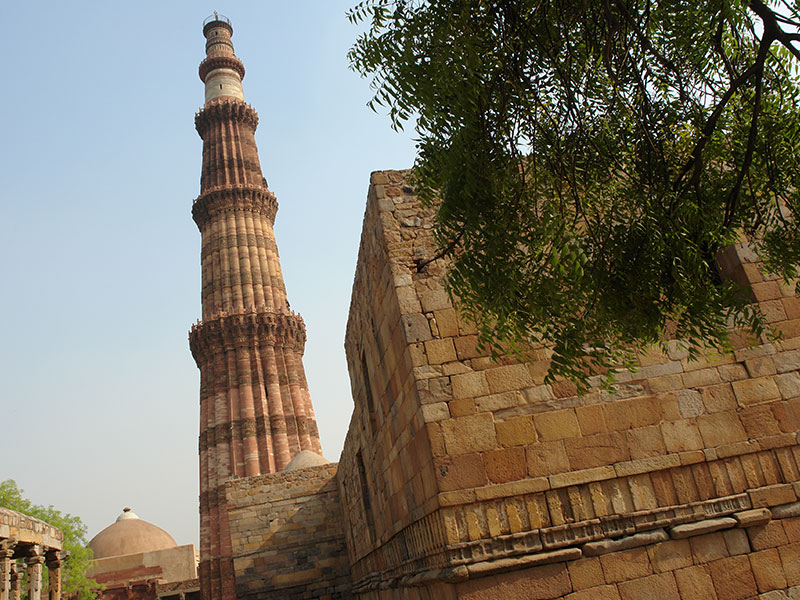
Delhi
Delhi has a number of tourist attractions, right from history to present. Museums, heritage, shopping -you name it, Delhi has it all. It’s astonishing heritage is the city's star attraction - both in terms of its monuments and its cultural offerings. Although there are sites in Delhi that one may tick off the travellers list, it is the Old Delhi area which has those lesser talked about places that cannot be missed.
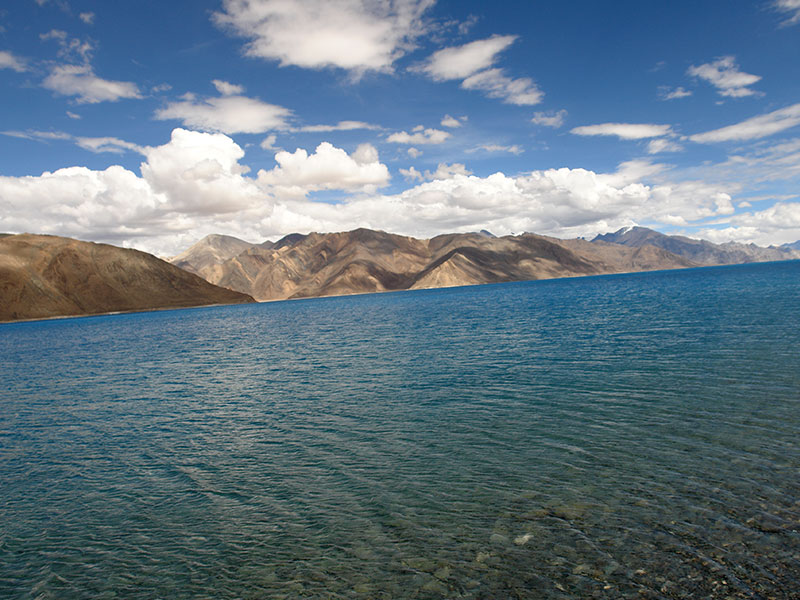
Leh Ladakh
Bordered by the Tibet Autonomous Region, Ladakh is pone of the most awe-inspiring places, owing to its breathtaking beauty, plethora of stupas and monasteries with intricate carvings, a medley of colours, a serene atmosphere and exquisite relics, centres of Buddhism dotting the landscape. The high-altitude lakes, rugged landscapes and gorgeous views make Ladakh the most fascinating region of the Himalayan Kingdom of India.
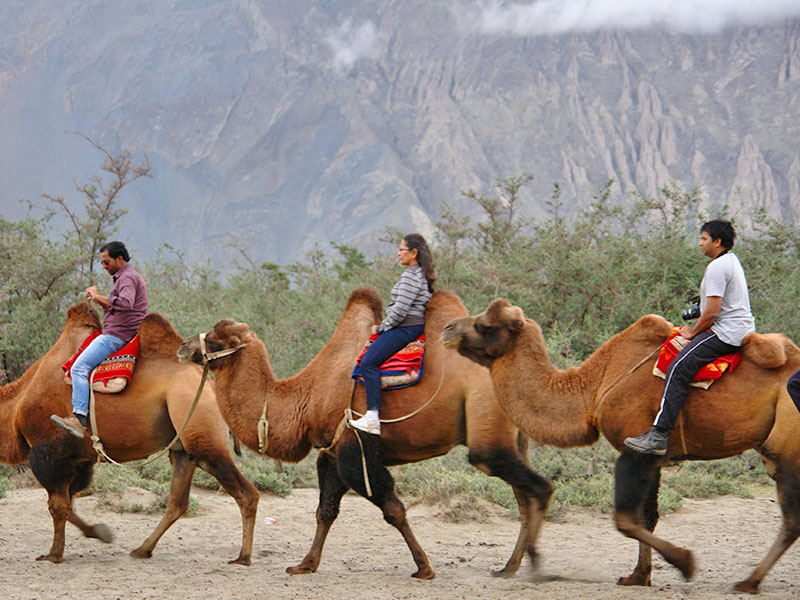
Nubra Valley
Nubra - often called valley of flowers, Nubra has Its inhabited areas forming a tri-armed valley cut by the Nubra and Shyok rivers. Diskit, the headquarters of Nubra, is about 150 km north from Leh, the capital of Ladakh. The Shyok River meets the Nubra River (or Siachan River) to form a large valley that separates the Ladakh and Karakoram Ranges. The main road access to Nubra is over Khardung La pass – the highest altitude road.
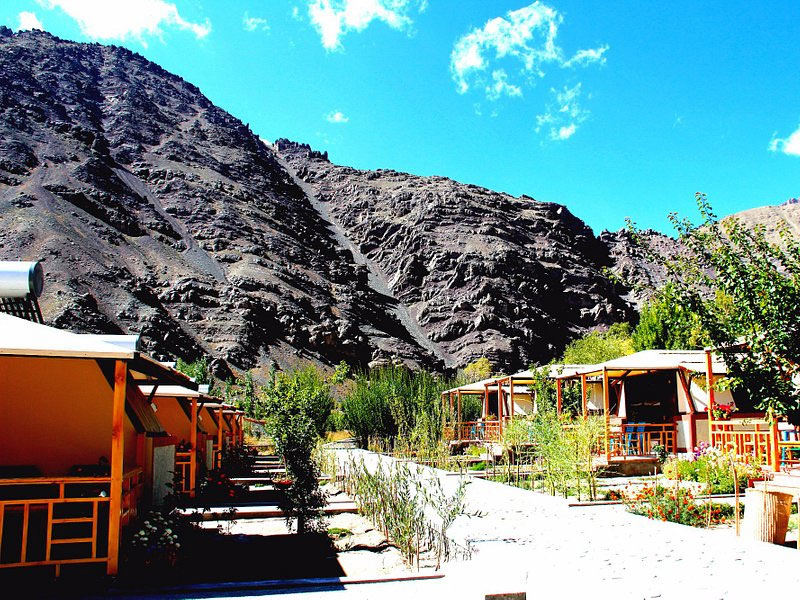
Uleytokpo
Free yourself from urban congestion in separate cottages sprawled over a large area among apple and apricot trees and the kitchen garden. Closeness to nature will relax your body and soul.
Spain / Delhi
Departure from Spain with flight to Delhi, with possible change of aircraft. Meals, overnight on board.
Delhi
Media pensión with breakfast on board. Arrive Delhi in the morning. Transfer to the hotel. Accommodation in reserved rooms, which will be available from 12:00. Afternoon panoramic tour of the colonial city with a stop at the government buildings in front of the India Gate and a visit to the spectacular Qutub Minar complex. Overnight.
Delhi / Leh
Media pensión. In the morning flight to Leh, the capital of Ladakh located at about 3500 meters above sea level. Afternoon rest necessary for acclimatisation. Overnight.
Leh
Media pensión. Visit of the Monastery of Thiksey, a large complex which houses an important study center for monks, and of that of Hemis, one of the most important in the country which preserves an excellent collection of sacred texts and the largest Tanka in the Ladakh Photo stop at Shey monastery. Afternoon visit Spituk monastery and Phyang monastery, with its many halls housing a collection of bronzes, ancient paintings and Tantric halls. Overnight.
Leh / Nubra Valley
Media pensión. Transfer to Nubra valley via the spectacular KardungLa pass at 5602m altitude. In the afternoon, visit the sunny Samstaling and Diskit monasteries. At sunset, walk on the sand dunes with the optional possibility of a Bactrian camel safari. Overnight stay.
Nubra Valley / Leh
Media pensión. In the morning, return to Leh. Afternoon visit of the Shanti Stupa from which you can enjoy an excellent view of the valley and time available for a walk in the Leh bazaar. Option to visit Sankar Gompa. Overnight.
Leh / Uleytokpo
Media pensión. Transfer to Uletokpo along the Indus valley. Along the way, visit two of the most beautiful monasteries in Ladakh: Likir and Alchi, an absolute masterpiece of frescoes dating back to the 11th century. Overnight stay.
Uleytokpo / Leh
Media pensión. In the morning, visit the Lamayuru monastery, the oldest Gompa in Ladakh, located on top of an incredible valley that recalls the lunar landscape. Return to Leh. Afternoon visit of the small monastery of Stakna and that of Matho, located in a suggestive landscape. Downhill walk through the pretty village. Overnight.
Leh / Delhi
Media pensión. Transfer to the airport. Flight to Delhi. Upon arrival, transfer to the hotel. Accommodation in reserved rooms, which will be available from 12.00. Afternoon at leisure for visits and optional excursions or for relaxation. Room available until departure. In the late evening, transfer to the airport. Boarding.
Delhi / Spain
In the very early hours of the morning (night between the penultimate and last day) departure for the airport of origin. Arrival at destination and end of our services.
The itinerary could vary where it is considered better to better adapt to the various festivals.
The Journey in brief
| Duration: | 10 Days / 8 Nights |
| Hotel: | Best available category A and above |
| Type: | Group Fixed Departure / Individual Private Tour |
| Departures: | Every Saturday (01st April 2023 - 23rd September 2023) |
| Guides: | Tour Escort Spanish Speaking |
| Meals: | Half board |
| The itinerary can also be created on an individual private basis with departures on free dates | |
Highlight of The Tour
- Guaranteed departures for a minimum of 4 people
- Q Select: maximum 16 participants (All Spanish Speaking)
- Many departures to coincide with major religious festivals
- One of the most exciting and moving journeys one can take in India
Currency adjustment blocked upon travel confirmation
The Grand New Delhi
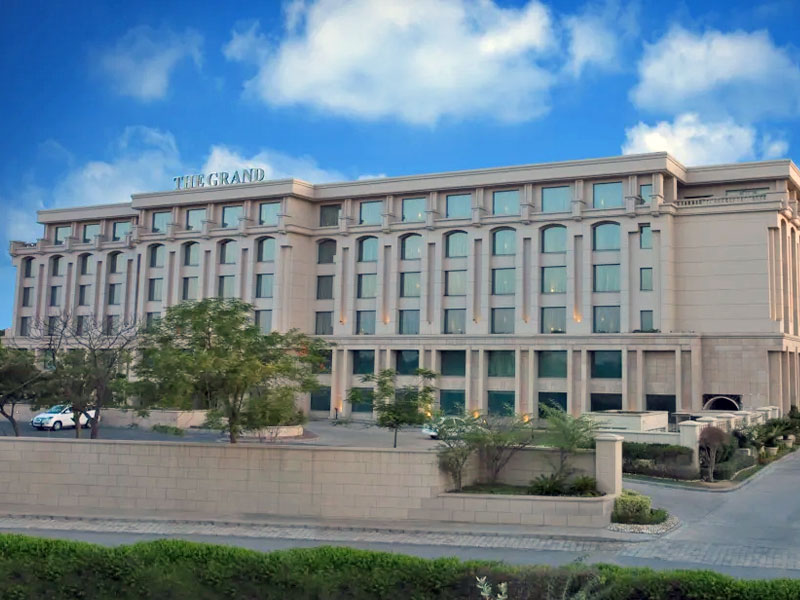
The Grand New Delhi
The Grand New Delhi, nestled in the heart of Delhi NCR, is the city's most distinguished luxury hotel. An ideal destination for the discerning business and leisure traveller, a 5-Star Luxury Hotel in New Delhi, boasts of modern facilities and a resort-like feel with luscious greens & magnificent waterscapes. A proud winner of the 'World Luxury Hotel Awards', the hotel with its personalized services and exemplary hospitality is the quintessential address to relax, unwind and explore the city at your own pace. Our 390 elegantly designed rooms and suites, 8 dining destinations and much-acclaimed spa oasis, all make The Grand New Delhi, one of the most popular 5-star hotels in Delhi. Featuring the iconic swimming pool, fitness centre and state-of-the-art event venues, our luxury hotel in Delhi caters to all leisure, fitness along with event needs of our guests.
The Grand Dragon Ladakh
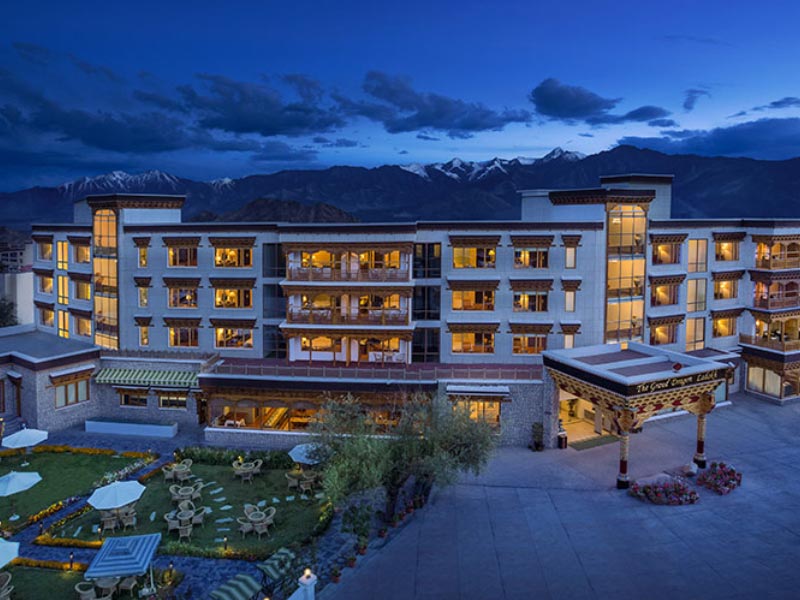
The Grand Dragon Ladakh
The Grand Dragon Ladakh, one of the first 5 star luxury hotels in Ladakh. It is decorated magnificently with handmade paintings by Gulam Mustafa (First modern Artist of Ladakh) around every corner, and fixtures that are reminiscent of royalty. The Grand Dragon Ladakh is the first hotel with a host of state of the art amenities, such as electronic key cards for the rooms and a baggage scanner, as well as their own sewage treatment facility. The entire facility is wheelchair accessible, for providing differently abled guests with a comfortable sojourn. The hotel is also centrally heated and solar powered, not only ensuring warmth but also ensuring that all our services are eco-friendly. The attention to detail offered by the associates, coupled with the magnificent views, will guarantee you take back home sweet memories.
Desert Himalaya Resort
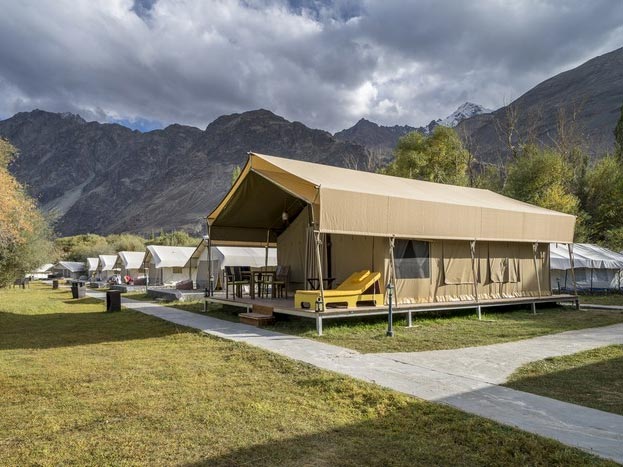
Desert Himalaya Resort
Desert Himalaya is a Luxury Resort nestled in the beautiful Nubra Valley. Due to its unique location in the valley, the Resort offers unparalleled views of the majestic Karakoram and Ladakh Range. Tucked within the lap of 6 acres of lush green land, surrounded by majestic mountain peaks and gently caressed by crystal clear meandering natural springs, Desert Himalaya offers an experience that encompasses unmatched luxury, comfort and adventure for its guests.
The Grand Dragon Ladakh

The Grand Dragon Ladakh
The Grand Dragon Ladakh, one of the first 5 star luxury hotels in Ladakh. It is decorated magnificently with handmade paintings by Gulam Mustafa (First modern Artist of Ladakh) around every corner, and fixtures that are reminiscent of royalty. The Grand Dragon Ladakh is the first hotel with a host of state of the art amenities, such as electronic key cards for the rooms and a baggage scanner, as well as their own sewage treatment facility. The entire facility is wheelchair accessible, for providing differently abled guests with a comfortable sojourn. The hotel is also centrally heated and solar powered, not only ensuring warmth but also ensuring that all our services are eco-friendly. The attention to detail offered by the associates, coupled with the magnificent views, will guarantee you take back home sweet memories.
ULE Ethnic Resort

ULE Ethnic Resort
Sham valley, situated on the Leh Srinagar highway is home to ancient monasteries, river gorges and ancient trek routes. Famous for its riverside assortment of beautiful villages, trekking routes, rafting passages and the best yield of apricots, Sham valley is the Eden of Ladakh. Set at the cliff bank of river Indus, 55 Kilometers into Sham valley is the village of Ule Tokpo. The village is home to the family running Ule Ethnic resorts since 1974. A premier property, Ule Ethnic resort with 15 ensuite deluxe cottages and 15 ensuite huts. Ule Ethnic Luxury Hotel, Resort is the first fully solar powered tourism project in Ladakh, taking ahead the local sustainable tourism initiative.
The Grand Dragon Ladakh

The Grand Dragon Ladakh
The Grand Dragon Ladakh, one of the first 5 star luxury hotels in Ladakh. It is decorated magnificently with handmade paintings by Gulam Mustafa (First modern Artist of Ladakh) around every corner, and fixtures that are reminiscent of royalty. The Grand Dragon Ladakh is the first hotel with a host of state of the art amenities, such as electronic key cards for the rooms and a baggage scanner, as well as their own sewage treatment facility. The entire facility is wheelchair accessible, for providing differently abled guests with a comfortable sojourn. The hotel is also centrally heated and solar powered, not only ensuring warmth but also ensuring that all our services are eco-friendly. The attention to detail offered by the associates, coupled with the magnificent views, will guarantee you take back home sweet memories.
The Grand New Delhi

The Grand New Delhi
The Grand New Delhi, nestled in the heart of Delhi NCR, is the city's most distinguished luxury hotel. An ideal destination for the discerning business and leisure traveller, a 5-Star Luxury Hotel in New Delhi, boasts of modern facilities and a resort-like feel with luscious greens & magnificent waterscapes. A proud winner of the 'World Luxury Hotel Awards', the hotel with its personalized services and exemplary hospitality is the quintessential address to relax, unwind and explore the city at your own pace. Our 390 elegantly designed rooms and suites, 8 dining destinations and much-acclaimed spa oasis, all make The Grand New Delhi, one of the most popular 5-star hotels in Delhi. Featuring the iconic swimming pool, fitness centre and state-of-the-art event venues, our luxury hotel in Delhi caters to all leisure, fitness along with event needs of our guests.
The Grand New Delhi

The Grand New Delhi
The Grand New Delhi, nestled in the heart of Delhi NCR, is the city's most distinguished luxury hotel. An ideal destination for the discerning business and leisure traveller, a 5-Star Luxury Hotel in New Delhi, boasts of modern facilities and a resort-like feel with luscious greens & magnificent waterscapes. A proud winner of the 'World Luxury Hotel Awards', the hotel with its personalized services and exemplary hospitality is the quintessential address to relax, unwind and explore the city at your own pace. Our 390 elegantly designed rooms and suites, 8 dining destinations and much-acclaimed spa oasis, all make The Grand New Delhi, one of the most popular 5-star hotels in Delhi. Featuring the iconic swimming pool, fitness centre and state-of-the-art event venues, our luxury hotel in Delhi caters to all leisure, fitness along with event needs of our guests.
The Grand Dragon Ladakh

The Grand Dragon Ladakh
The Grand Dragon Ladakh, one of the first 5 star luxury hotels in Ladakh. It is decorated magnificently with handmade paintings by Gulam Mustafa (First modern Artist of Ladakh) around every corner, and fixtures that are reminiscent of royalty. The Grand Dragon Ladakh is the first hotel with a host of state of the art amenities, such as electronic key cards for the rooms and a baggage scanner, as well as their own sewage treatment facility. The entire facility is wheelchair accessible, for providing differently abled guests with a comfortable sojourn. The hotel is also centrally heated and solar powered, not only ensuring warmth but also ensuring that all our services are eco-friendly. The attention to detail offered by the associates, coupled with the magnificent views, will guarantee you take back home sweet memories.
Desert Himalaya Resort

Desert Himalaya Resort
Desert Himalaya is a Luxury Resort nestled in the beautiful Nubra Valley. Due to its unique location in the valley, the Resort offers unparalleled views of the majestic Karakoram and Ladakh Range. Tucked within the lap of 6 acres of lush green land, surrounded by majestic mountain peaks and gently caressed by crystal clear meandering natural springs, Desert Himalaya offers an experience that encompasses unmatched luxury, comfort and adventure for its guests.
ULE Ethnic Resort

ULE Ethnic Resort
Sham valley, situated on the Leh Srinagar highway is home to ancient monasteries, river gorges and ancient trek routes. Famous for its riverside assortment of beautiful villages, trekking routes, rafting passages and the best yield of apricots, Sham valley is the Eden of Ladakh. Set at the cliff bank of river Indus, 55 Kilometers into Sham valley is the village of Ule Tokpo. The village is home to the family running Ule Ethnic resorts since 1974. A premier property, Ule Ethnic resort with 15 ensuite deluxe cottages and 15 ensuite huts. Ule Ethnic Luxury Hotel, Resort is the first fully solar powered tourism project in Ladakh, taking ahead the local sustainable tourism initiative.
India
Journey to India.......once is not enough!!!!
BANKING AND CURRENCY
Currency
The Indian Rupee is the official currency of the Republic of India. The modern Indian Rupee is subdivided into 100 paise (singular paisa). Banknotes in circulation come in denominations of INR 5, 10, 20, 50, 100, 500 and 2000. Please note that as of November 2016, the older 500 and 1000 INR note are no longer valid legal tender and only new ₹500 notes will be accepted.
The latest Indian Rupee coins are available in denominations of INR 1, 2, 5, 10.
The import and export of local currency is prohibited. The import of foreign currency is unlimited. However, amounts exceeding US$5,000 or equivalent in cash, or US$10,000 or equivalent in all forms of currency must be declared. The export of foreign currency is allowed up to the amount imported and declared.
Currency can be changed at banks, airports or authorised money changers. Many hotels also have facilities to change money but this is a more expensive option. It is illegal to exchange money through unauthorised money changers. US Dollars and Pounds Sterling are the easiest currencies to exchange.
Banking
Banking hours: Monday-Saturday 10h00-03h30 (Bank will be closed on second and forth Saturday).
Strictly speaking, you can neither import nor export Indian currency, but you can get some at the airport straight away to at least get you transport to your accommodation. There are Authorized Foreign Exchange dealers in most big cities, and banks will also change your currency at a fair rate if you have time for the paperwork.
A good way of getting your travellers currency is via an ATM but beware of hidden bank charges, both from the bank providing the ATM and the card-issuing bank - you also do not know what exchange rate you are getting.ATMs are found in most towns and are recommended for cash withdrawals.
Visa, MasterCard and American Express are usually accepted in tourist hotels and many other shops. Debit cards are also widely accepted.
Travellers cheques are widely accepted and may be changed at banks and larger hotels. The most widely accepted currencies include US Dollars and Pounds Sterling. Some banks may refuse to change certain brands of traveller's cheques whilst others may exchange quite happily.
TRAVEL, TRANSPORT AND GETTING AROUND
India is big and there are lots of interesting ways to travel around it, most of which could not very well be described as efficient or punctual. Allow considerable buffer time for any journey with a fixed deadline (eg. your flight back), and try to remember that getting there should be half the fun.
India's large size and uncertain roads make flying a viable option, especially as prices have tumbled in the last few years. Even India's offshore islands and remote mountain states are served by flights, the main exceptions being Sikkim and Arunachal Pradesh (although crossing over from neighbouring states is fairly easy). Due to the aviation boom over the last few years, airports have not been able to keep up with the air traffic. Most Indian airports continue to function with one runway and a handful of boarding gates. Check in and security queues can be terribly long, especially in Delhi and Mumbai.
Railways were introduced in India in 1853, more than one and half a centuries ago, by the British, and today India boasts of the biggest network of railway lines in the world, and the rail system is very efficient, if not always on schedule. Travelling on Indian Railways gives you the opportunity to discover the Indian landscape and scenic beauty first hand and is generally more economical than flying domestic. It is one of the safest ways of travel in India. With classes ranging from luxurious to regular, it's the best way to get to know the country and its people. Most train passengers will be curious about you and happy to pass the time with a chat.
In central locations of big cities like airports or stations reliable pre-paid taxis are available and will save you money as well as the bargaining hassle. However beware of touts who would claim themselves to be running pre-paid taxis. Always collect the receipt from the counter first. The receipt has two parts - one part is for your reference and the other part you will need to handover to the taxi driver only after you reach your desired destination. The taxi driver will get his payment by submitting or producing this other part to the pre-paid taxi counter. Normal taxis running by meter are usually more common. In many non Metro Cities (or even in Metros depending on time) taxies or autos may ply without the usual meter.
While you can't take a cross-country bus-ride across India, buses are the second most popular way of travelling across states and the only cheap way of reaching many places not on the rail network (eg. Dharamsala).
FOOD, DRINK AND CUISINE ADVICE
Water for drinking, brushing teeth or making ice should first be boiled or otherwise sterilised. Milk is often unpasteurised and should be boiled. Avoid dairy products likely to have been made from non-boiled milk. Only eat well-cooked meat and fish. Do not eat salads, vegetables should be cooked and peel your own fruit. Don’t eat street vendor food unless it is piping hot. Tap water is not safe to drink, rely on bottled water which is widely available. However, do check the seal on bottled water.
Indian food is world-renowned for its tantalising flavours, spiciness and enormous variety. Curries are created from the subtle and delicate blending of spices such as cumin, turmeric, cardamom, ginger, coriander, nutmeg and poppy seed although these vary from region to region and every spice has medicinal properties and use.
Vegetable dishes are more common than in Europe, particularly in the fruity, coconutty dishes of southern India, while northern India has an entirely different but equally satisfying cuisine to sample. Breads like paranthas, chapatis, naans and rotis are also part of the main diet in several states like Punjab, Haryana and Uttar Pradesh. Achars (pickles), relishes and chutneys again vary by region and add more resonance to amazing meals.
Sweets or mithai too have regional specialities. They tend to be milk based and some are syrupy and fried. Well-known northern sweets are gulab jamun, jalebi (it’s worth watching how these syprup-based confections are made in the street), kulfi, kheer, halwa and laddu. From the east are rasgulla and rasmalai. The south has several burfi and halwa-type desserts like coconut burfi and badam halwa made from almonds.
While care should be taken in where one eats, exceptional food can be had in the most humble surroundings such as food at ashrams as can be found in 5-star restaurants. Non-vegetarians will find fabulously spiced mutton dishes according to regional specialities including fish dishes typical to coastal areas.
10 to 15% is usual in restaurants that impose no service fee; optional where service fee is added to bill.
CLIMATE AND WEATHER
The weather is mainly hot most of the year with significant variations from region to region. The coolest weather lasts from around the end of November to the beginning of March, with fresh mornings and evenings, and mostly sunny days. The really hot weather, when it is dry, dusty and unpleasant, is between March and June. Monsoon rains occur in most regions in summer anywhere between June and early October.
CLOTHING AND DRESS RECOMMENDATIONS
Male or female, one rule covers all visitors to India: don't leave the house with your arms or legs bare. You'll naturally get attention as a foreigner, as full-on staring is common and accepted on Indian streets, but you'll suffer far less negative attention if you remain covered up. For most locations and seasons in India, thin, loose linen or cotton pants and button-down shirts will keep you comfortable in hot, humid weather and help you blend in. While you may see Indian young adults sporting tight jeans and fitted brand-name tops, you'd stand out significantly more in the same outfit. If you visit anywhere in northern India - not just the mountains, Delhi too - during the winter, prepare for seriously cold weather. Bring jeans and heavy shirts and pick up an Indian wool wrap.
What you can get away with at an Indian beach depends entirely on which beach you visit. In the state of Goa, a popular beach and club getaway destination, locals are accustomed to seeing tourists in bikinis on the beach and Indian men often sport Speedos. But skimpy clothes need to stay on the beach. Don't walk around town or your hotel in nothing but a bikini and sarong. In less Western-frequented beach destinations, such as the beaches around Bombay, Alibag and Chowpatty, or anywhere in the south, hit the beach in light pants and a tunic.
When visiting temples and other religious sites on your own or part of a tour, be on the lookout for signs advising visitors to dress in a specific way to enter the temple. The government of India advises that some religious institutions require visitors to cover their heads or remove their shoes, and covering your legs and arms in respect goes without saying. Certain sites may carry more specific requirements, such as donning a certain colored sash or sarong-like covering. Take your cue from other visitors exiting the site.
ELECTRICITY AND PLUG STANDARDS
For the most part, electrical sockets (outlets) in India are the "Type D" 5 amp BS-546 sockets. This is actually an old British standard. The "Type D" Indian plug and socket is not to be confused with the "Type M" South African plug and socket. In pictures, they look very similar, but the South African type is much larger than the Indian type, and they are physically incompatible. If your appliance's plug doesn't match the shape of these sockets, you will need a travel plug adapter in order to plug in.
Electrical sockets (outlets) in India usually supply electricity at between 220 and 240 volts AC. If you're plugging in an appliance that was built for 220-240 volt electrical input, or an appliance that is compatible with multiple voltages, then an adapter is all you need. If your appliances are not compatible with 220-240 volt electrical output, a voltage converter will be necessary.